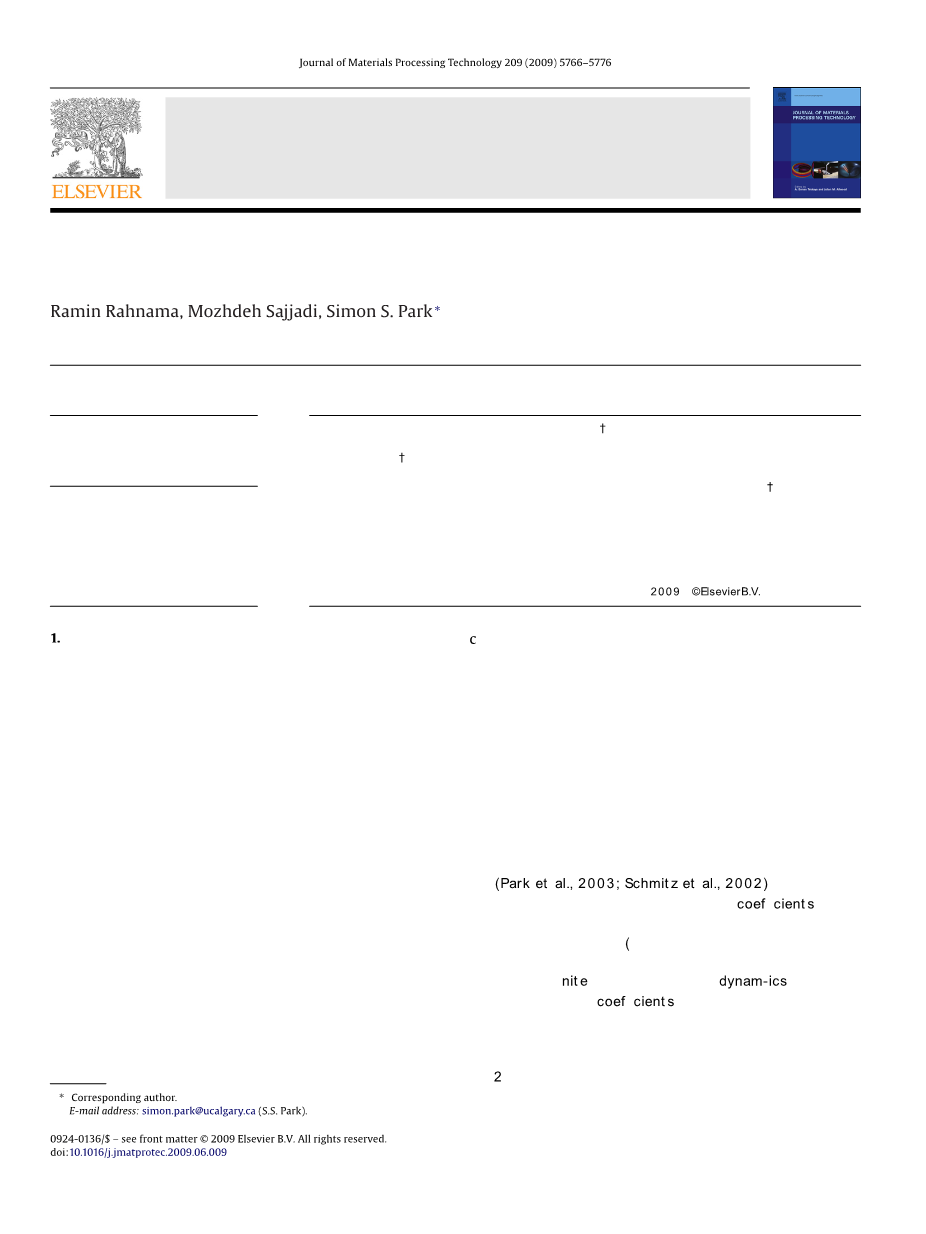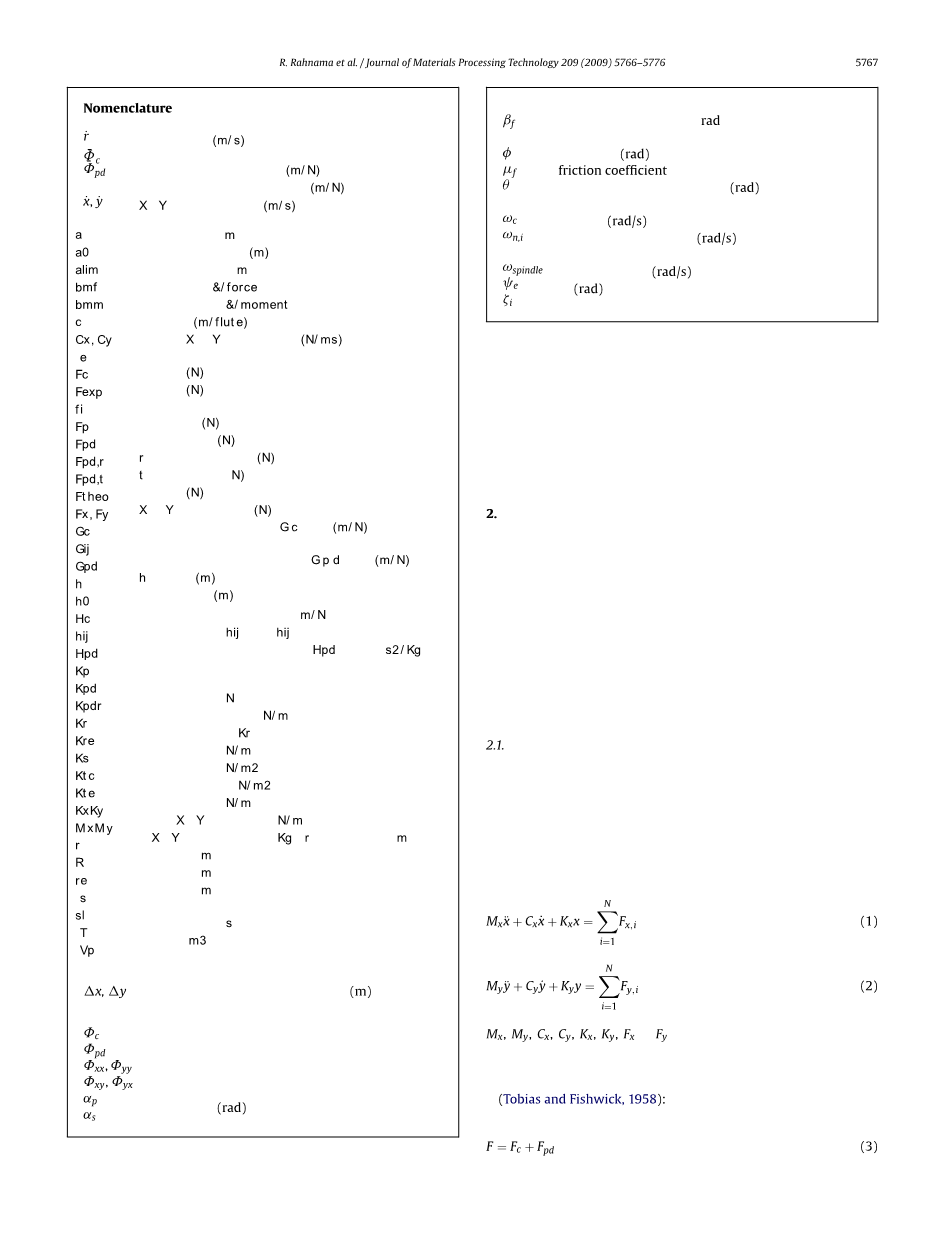Journal of Materials Processing Technology 209 (2009) 5766–5776
Contents lists available at ScienceDirect
Journal of Materials Processing Technology
journal homepage: www.elsevier.com/locate/jmatprotec
Chatter suppression in micro end milling with process damping
Ramin Rahnama, Mozhdeh Sajjadi, Simon S. Park∗
Micro Engineering Dynamics Automation Laboratory (MEDAL), Department of Mechanical and Manufacturing Engineering, University of Calgary, Calgary, AB, Canada T2N 1N4
a r t i c l e i n f o a b s t r a c t
Article history:
Received 2 February 2009
Received in revised form 14 June 2009 Accepted 15 June 2009
Keywords: Chatter Micro milling
Process damping Receptance coupling
Micro milling utilizes miniature micro end mills to fabricate complexly sculpted shapes at high rotational speeds. One of the challenges in micro machining is regenerative chatter, which is an unstable vibration that can cause severe tool wear and breakage, especially in the micro scale. In order to predict chat- ter stability, the tool tip dynamics and cutting coefficients are required. However, in micro milling, the elasto-plastic nature of micro machining operations results in large process damping in the machining process, which affects the chatter. We have used the equivalent volume interface between the tool and the workpiece to determine the process damping parameter. Furthermore, the accurate measurement of the tool tip dynamics is not possible through direct impact hammer testing. The dynamics at the tool tip is indirectly obtained by employing the receptance coupling method, and the mechanistic cutting coeffi- cients are obtained from experimental cutting tests. Chatter stability experiments have been performed to examine the proposed chatter stability model in micro milling.
© 2009 Elsevier B.V. All rights reserved.
Introduction
Micro milling operations can be used to manufacture complex 3D miniature components from a variety of engineering materials, especially engineering alloys. The micro milling process is similar to the macro operation, where the spindle rotates an end mill (minia- ture end mill in micro milling) to remove a portion of the workpiece; and, as with macro machining operations, micro machining pro- cesses also exhibit an unstable phenomenon called regenerative chatter (Mascardelli et al., 2008; Altintas and Budak, 1995), due to changes in the chip thickness. Chatter can cause serious damage in the micro scale, since the tolerances are generally tight and small vibrations can break the tool and ruin the part. Due to fragile nature of micro tools, a small chip thickness is used to remove a portion of the workpiece, in order to minimize excessive loads and prevent tool breakage and large deflections.
Micro machining phenomena differ from macro machining due to size effects, which occur because the edge radius of micro tools is comparable to the uncut chip thickness, resulting in large neg- ative rake angles (Vogler et al., 2003). This is particularly evident at low feed rates, where the effects of plowing are more signifi- cant (Malekian et al., 2009). Process damping can increase stability, especially at low spindle speeds (Tobias and Fishwick, 1958; Kegg, 1969; Tlusty, 1993). Elastic recovery increases the friction between the flank face of the tool and the workpiece and amplifies the effect of process damping. Haung and Junz Wang (2007) assumed that
E-mail address: simon.park@ucalgary.ca (S.S. Park).
cutting forces (including process damping) contribute to two phys- ical mechanisms—chip shearing and plowing, where the shearing force is proportional to the chip thickness and the plowing force is proportional to the contact length between the cutting edge and the machined surface. Chiou et al. (1995) presented a model for chatter stability for turning that considered the effect of tool wear. In their model, the process damping force due to tool wear was assumed to be proportional to the volume of the deformed workpiece material under the clearance face of the tool.
The objectives of this paper are the examination of micro end milling processes with process damping and the formulation of the chatter stability method. We have extended Tlusty’s (2000) conven- tional chatter theorem by incorporating process damping, which is a function of the interference volume between the tool and the workpiece (Wu and Liu, 1985).
In order to accurately predict chatter stability, the accurate mea- surement of tool tip dynamics and the cutting coefficients are also needed. Since experimental impact hammer tests cannot be per- formed on fragile tool tips, we have utilized the receptance coupling method (Park et al., 2003; Schmitz et al., 2002) to indirectly couple the machine tool dynamics with arbitrary tool dynamics to iden- tify the tool tip dynamics. This involves the mathematical coupling of the experimental frequency response functions and the dynam- ics acquired using the finite element analysis method. Furthermore, the mechanistic cutting force model
剩余内容已隐藏,支付完成后下载完整资料


英语译文共 11 页,剩余内容已隐藏,支付完成后下载完整资料
资料编号:[419429],资料为PDF文档或Word文档,PDF文档可免费转换为Word
以上是毕业论文外文翻译,课题毕业论文、任务书、文献综述、开题报告、程序设计、图纸设计等资料可联系客服协助查找。


